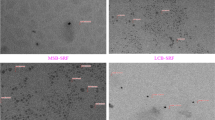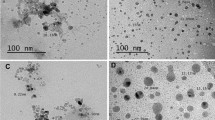Abstract
In this study, a novel slow release carrier for the controlled release of citric acid (CA), hydroxypropyl chitosan-graft-carboxymethyl-β-cyclodextrin (HPCS-g-CMCD) was synthesized by the grafting reaction of carboxymethyl-β-cyclodextrin (CMCD) with hydroxypropyl chitosan (HPCS), and the structural characteristics of HPCS-g-CMCD were confirmed by FT-IR, TGA, and NMR. Based on HPCS-g-CMCD and CA, slow release citric acid (SRCA) was prepared by a spray drying method. HPCS-g-CMCD carrier has a better slow release performance for CA compared to HPCS and CMCD, and CA release mechanism was attributed to a Fickian diffusion. Furthermore, the release behavior of uranium in contaminated soil could be effectively controlled by SRCA. The effects of SRCA on improving the phytoremediation capacity in uranium-contaminated soil were investigated using Brassica juncea, which were grown in pots containing soil with uranium at 56 mg kg−1. After 50 days of growth, 5 mmol kg−1 of CA, SRCA I, SRCA II, and SRCA III was applied, respectively. The results showed that slow release citric acid could enhance the uptake of uranium in Indian mustard. Uranium concentration in the root with SRCA I treatment was increased by 80.25% compared to the control, and the uranium removal efficiency of the SRCA I treatment was 1.66-fold greater than that of the control. Simultaneously, the leaching loss of uranium in SRCA I-treated soil was decreased by 37.35% compared to CA-treated soil. As a promising remediation strategy, SRCA-assisted phytoremediation may provide a kind of feasible technology with low leaching risk for remediation of uranium-contaminated soils.





Similar content being viewed by others
Data availability
All data generated or analyzed during the current study are included in this published article.
References
Bian XG, Cui J, Tang BP, Yang L (2018) Chelant-induced phytoextraction of heavy metals from contaminated soils: a review. Pol J Environ Stud 27:2417–2424
Chabalala S, Chirwa EMN (2010) Uranium (VI) reduction and removal by high performing purified anaerobic cultures from mine soil. Chemosphere 78:52–55
Dai RJ, Zhang S, Li F, Jin H, Gu JL, Fu RN (1998) Synthesis and characterization of water-soluble beta-cyclodextrin derivatives used as pseudostationary phases for capillary electrophoresis. Acta Chim Sin 56:594–599
Dash S, Murthy PN, Nath L, Chowdhury P (2010) Kinetic modeling on drug release from controlled drug delivery systems. Acta Pol Pharm 67:217–223
Gundogdu E, Ilem-Ozdemir D, Ekinci M, Ozgenc E, Asikoglu M (2015) Radiolabeling efficiency and cell incorporation of chitosan nanoparticles. J Drug Deliv Sci Technol 29:84–89
Huang JWW, Blaylock MJ, Kapulnik Y, Ensley BD (1998) Phytoremediation of uranium-contaminated soils: role of organic acids in triggering uranium hyperaccumulation in plants. Environ Sci Technol 32:2004–2008
Khlibsuwan R, Pongjanyakul T (2015) Spray-dried chitosan-magnesium aluminum silicate microparticles as matrix formers in controlled release tablets. J Drug Deliv Sci Technol 30:114–122
Kim GN, Kim I, Kim SS, Choi JW (2016) Removal of uranium from contaminated soil using indoor electrokinetic decontamination. J Radioanal Nucl Ch 309:1175–1181
Kono H, Onishi K, Nakamura T (2013) Characterization and bisphenol A adsorption capacity of β-cyclodextrin-carboxymethylcellulose-based hydrogels. Carbohydr Polym 98:784–792
Li J, Zhang Y (2012) Remediation technology for the uranium contaminated environment: a review. Procedia Environ Sci 13:1609–1615
Li HF, Wang QG, Cui YS, Dong YT, Christie P (2005) Slow release chelate enhancement of lead phytoextraction by corn (Zea mays L.) from contaminated soil-a preliminary study. Sci Total Environ 339:179–187
Li C, Wang M, Luo X, Liang L, Han X, Lin X (2019) Accumulation and effects of uranium on aquatic macrophyte nymphaea tetragona georgi: potential application to phytoremediation and environmental monitoring. J Environ Radioact 198:43–49
Lu RK (2000) Analytical methods for soil and agricultural chemistry. China Agricultural Science and Technology Press, Beijing, pp 106–185
Ma PJ, Wang Z, Yi FC, Niu SJ, Zhou HT (2017) Spatial distribution and pollution assessment of uranium in soil around uranium tailings. Atomic Energy Sci Technol 51:956–960
Maderuelo C, Zarzuelo A, Lanao JM (2011) Critical factor in the release of drugs from sustained release hydrophilic matrices. J Control Release 154:2–19
Malaviya P, Singh A (2012) Phytoremediation strategies for remediation of uranium- contaminated environments: a review. Crit Rev Environ Sci Technol 42:2575–2647
Mohamed T, Juan AO, Inmaculada GR (2002) Production of xyloglucanolytic enzymes by Trichoderma viride, Paecilomyces farinosus, Wardomyces inflatus, and Pleurotus ostreatus. Mycologia 94:404–410
Ouyang W, Huang W, Hao X, Tysklind M, Haglund P, Hao F (2017) Watershed soil Cd loss after long-term agricultural practice and biochar amendment under four rainfall levels. Water Res 122:692–700
Pan ZZ, Giammar DE, Mehta V, Troyer LD, Catalano JG, Wang ZM (2016) Phosphate-induced immobilization of uranium in Hanford Sediments. Environ Sci Technol 50:13486–13494
Qi FF, Zha ZY, Du L, Feng XJ, Wang DN, Zhang D, Fang ZD, Ma LJ, Jin YD, Xia CQ (2014) Impact of mixed low-molecular-weight organic acids on uranium accumulation and distribution in a variant of mustard (Brassica juncea var. tumida). J Radioanal Nucl Chem 302:149–159
Radu AD, Panturu E, Woinaroschy A, Isopescu R (2015) Experimental design and process optimization for uranium polluted soils decontamination by acid washing. Water Air Soil Pollut 226:1–11
Radu CD, Parteni O, Ochiuz L (2016) Applications of cyclodextrins in medical textiles – review. J Control Release 224:146–157
Ritger PL, Peppas NA (1987) A Simple equation for the description of solute release II. Fickian and anomalous release from swellable devices. J Control Release 5(1):37–42
Shahandeh H, Hossner LR (2002) Role of soil properties in phytoaccumulation of uranium. Water Air Soil Pollut 141:165–180
Shibata M, Konno T, Akaike R, Xu Y, Shen RF, Ma JF (2007) Phytoremediation of Pb contaminated soil with polymer-coated EDTA. Plant Soil 290:201–208
Siepmann J, Peppas NA (2001) Modeling of drug release from delivery systems based on hydroxypropyl methylcellulose (HPMC). Adv Drug Deliv Rev 48:139–157
Song LX, Wang HM, Teng CF, Bai L, Xu P, Guo XQ (2008) Theoretical and experimental studies of the inclusion phenomena of beta-cyclodextrin with organic amines. Chin J Chem 26(9):1702–1708
Wang K, Liu Y, Song Z, Wang D, Qiu W (2019) Chelator complexes enhanced Amaranthus hypochondriacus L. phytoremediation efficiency in Cdcontaminated soils. Chemosphere 237:124480
Xie WM, Xu PX, Wang W, Liu Q (2002) Preparation and antibacterial activity of water-soluble chitosan derivative. Carbonhyd Polym 50:35–40
Xie ZY, Wu LH, Chen NC, Liu CS, Zheng YJ, Xu SG, Li FB, Xu YL (2012) Phytoextraction of Pb and Cu contaminated soil with maize and microencapsulated EDTA. Int J Phytoremediat 14(8):727–740
Yuan ZT, Ye YJ, Gao F, Yuan HH, Lan MB, Lou KY, Wang W (2013) Chitosan-graft-β-cyclodextrin nanoparticles as a carrier for controlled drug release. Int J Pharm 446:191–198
Zhang G, Gong Z (2012) Soil survey laboratory methods. Science Press, Beijing, pp 8–82
Zhu YL, Pilon-Smits EAH, Tarun AS, Weber SU, Lise J, Norman T (1999) Cadmium tolerance and accumulation in Indian Mustard is enhanced by overexpressing γ-glutamylcysteine synthetase. Plant Physiol 121(4):1169–1177
Funding
This work was financed by the National Natural Science Foundation of China (41761069) and Jiangxi Provincial Natural Science Foundation of China (20181ACB20004, 20202BABL203027).
Author information
Authors and Affiliations
Contributions
All authors contributed to the study conception and design. Material preparation, data collection, and analysis were performed by Bing Wang and Wenzhe Fan. The supervision, discussion of results, and suggestion of the research point were performed by prof. Guanghui Wang and prof. Nansheng Deng. The first draft of the manuscript was written by Guanghui Wang. All authors read and approved the final manuscript.
Corresponding author
Ethics declarations
Ethics approval and consent to participate
Not applicable.
Consent for publication
Not applicable.
Competing interests
The authors declare no competing interests.
Additional information
Responsible Editor: Elena Maestri
Publisher’s note
Springer Nature remains neutral with regard to jurisdictional claims in published maps and institutional affiliations.
Rights and permissions
About this article
Cite this article
Wang, G., Wang, B., Fan, W. et al. Enhanced phytoremediation of uranium-contaminated soils by Indian mustard (Brassica juncea L.) using slow release citric acid. Environ Sci Pollut Res 28, 61061–61071 (2021). https://doi.org/10.1007/s11356-021-14964-6
Received:
Accepted:
Published:
Issue Date:
DOI: https://doi.org/10.1007/s11356-021-14964-6




